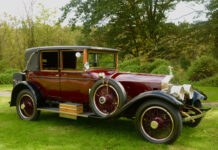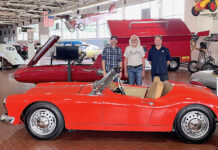By Jay Hirsch
The 1939 Chevrolet Master Business Coupe seen here is “the best of both worlds,” as its owner and builder Hank Dahl would say. That is, it retains the basic art-deco body style of the time period but with modern updates under the hood and in the passenger compartment
Hank chose the 1939 Chevy for his latest project, because the car has a longer hood than the 1938, the headlights sit on top of the front fenders, the grille has horizontal bars and the car was “rounder and smoother” over the previous year’s models. The Master Series also had twin tail lights which were optional on the lesser series of Chevys.
This car was a rust-free-car from New Mexico. The previous owner, who lived in Maryland, had started to do work on the car himself, which turned out to be too much of a project, and he could not afford to pay a shop to build his car. He subsequently offered the car for sale in several car magazines devoted to older cars.
Hank saw the ad for the car, called the owner, went to see the car and obviously bought it.
“Luckily the guy did not have the money to do what he wanted to do, because he did not possess the skill to implement his ideas,” Hank told me.
The owner had installed a disc brake set up, with discs in the front and the rear still with drum brakes. The motor was a worn out 283 V-8.
When Hank started the car just to see how it would run, the brakes were “awful.” Turns out the owner did not put a proportion valve in for the disc/drum set up. This did not bother Hank, as his plans for the car included four-wheel disc brakes, a Chevy 350 crate engine, turbo 400 transmission, air-conditioning, etc. The body was “rock solid” with no rust, and that was Hank’s main concern. It was a blessing in disguise that the 283 ran so poorly, for if the engine was any good, the guy would have surely had an accident, since he did not have that proportion valve for the disc/drum operation. It was a $30 or less item, and the guy thought he did good with installing disc brakes.
After trailering the car home and into his garage, Hank undertook a 10-month rebuilding of the car. The body was stripped of its New Mexico-sun-burnt-faded paint, the passenger compartment gutted, much work done on the chassis for the updated suspension and four-wheel-disc brake which does not require a proportion valve since brake pressure is equal at all four wheels,
The chrome was sent out for re-plating, and then there was the choice of color to be decided upon. The original color was Bordeaux Maroon. Maroon was one of those colors of the 1930s and 1940s that, depending on the year the color was applied and the car it was painted on, varied from almost black to a medium dark red. Hank had his paint guy make some half pints of some late 1960s Chevrolet colors and the color you see on the car is the result of spraying sheet metal with those varied shades. It is not the same shade as the original Bordeaux Maroon, which Hank was fond of, but it is a color that “could have been,” in Hank’s outlook ,and it goes with the time period of the car.
As for the headlights and tail lights on the car, the tail lights are LEDs and the head lights are custom lights for cars from the 1920s and later. The outer and inner edge of the head lights have amber LEDs. The outer edge has the turn signal lights, and the inner edge is the parking light, while the head light has a bright halogen bulb, with all this behind a crystal like glass. Quite an improvement over the old six-volt bulbs, and yet retaining all the design elements of how the car looked in 1939. Hank did not want to install parking lights or directional lights either on the fenders or near the grill since the car did not have them in 1939.
The suspension of the Chevy was lowered about three inches, and that along with the 205/75 x 15 tires on the front and the 225/75 x 15 on the rear brought the car down about another four to six inches in height under the original 600 x 6 tires. Hank did not want to go bigger than the 225/75 x 15s on the rear, for he wanted the visual appearance of the car to appear “stock” to the average person. Any person who “knows” about cars would realize the car is far from stock. That is also apparent when looking at the interior. The original 1939 had a three-speed-manual, floor-mounted-transmission, which was in the center of the floor and about three feet tall. Now it has a column-mounted automatic with a modern steering wheel. The dash is original with reproduction dials that appear “original,” with the great-looking art-deco facade of the radio being restored.
This 1939 Chevrolet was built by Hank to drive and enjoy. It is not a “trailer queen,” although the condition of the car makes it appear to be. The 350 Chevy V-8 can effortlessly cruise at 75 mph to 85 mph. All too often cars with a “blown 454” end up being trailered. Since you have a car you cannot cruise on the highway hour after hour and cruising around town gets to be too noisy. This ’39 is quiet and smooth, and that is what Hank wanted,
The original inline OHV six-cylnder engine is called the Stovebolt Six. Chevrolet introduced it in 1929, and it was made until 1963, growing in size from the 181 cid in 1929 to 207 cid, 216 cid, 235, cid and finally 261 cid. The Stovebolt Six was a workhorse of an engine which Chevrolet used in their pick-up trucks
The term “stovebolt” referred to the use of quarter-inch-x-20 slotted bolts on various engine components. They were similar to bolts used on cast iron wood burning stoves, which were popular at the time, hence the name “stovebolt,” which has stuck since 1929
Hank has been building cars “as he see’s them” for more than 40 years. He is partial to cars from the 1930s and 1940s. •



